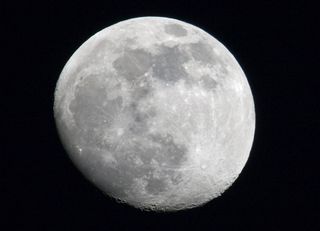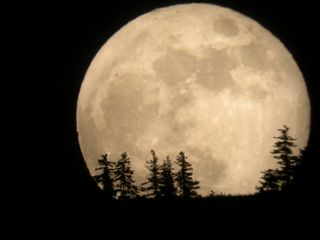
'Supermoon' Rising: How to Photograph This Weekend's Full Moon

The largest full moon of the year will rise this weekend, and for any shutterbugs hoping to snap photos of the so-called "supermoon," following some easy guidelines can help people make the most of their moon shots.
On Sunday (June 23), the moon will reach the closest point to Earth in its asymmetrical orbit, and will appear roughly 14 percent larger and 30 percent brighter than the full moon at its farthest point from the planet, according to SPACE.com. Photographing the supermoon does not require much special equipment, but the trick to capturing more than just a bright, white blob is to think like a camera, said Jason Mrachina, a professional photographer based in Des Moines, Iowa.
"To your camera, the moon is extremely bright, especially compared to a black background," Mrachina told LiveScience. "It's kind of akin to taking a picture of a bare light bulb in a black room, and wondering why you can't see the filament. When you're shooting at night, the relative difference between light and dark is extremely high, so you have to take that into consideration." [Full Moon Rising: Glitzy Photos of a Supermoon]
Tripods are key
To start, photographers should use a tripod to avoid taking blurry images. The best results come from holding the camera very still, and one of the biggest mistakes people make is trying to hold the camera steady by hand, Mrachina said.
He also recommends using a long lens — generally 200 millimeters or longer — to capture the dazzling lunar display.
"If you take the photo with a camera phone, or a wide-angle point-and-shoot without an optical zoom, you're going to be unhappy because the moon is going to look tiny in the image," Mrachina said. "With too wide of an angle, you don't get much of the moon to fill the frame."
Sign up for the Live Science daily newsletter now
Get the world’s most fascinating discoveries delivered straight to your inbox.
Another key way to manage the sharp contrast between light and dark in moon photos is to adjust the camera's settings. This involves manually setting the shutter speed and aperture, which acts as the iris of the camera and regulates how much light will be allowed into the lens, and changing the ISO, which refers to the sensitivity of the photo cell in the camera.
"As soon as you tell people not to shoot in automatic mode, you lose a lot of people who are too scared to try it," Mrachina said. "But, it's actually not hard, and with the manual settings, you will instantly get better results than if you had shot automatic."

Recommended camera settings
Since the moon is bright and moves quickly, photographers need to use a fast shutter speed. "The moon traverses the sky very quickly, so you have to have a shutter speed that can capture the frame and stop the motion of the moon, while also keeping the image properly exposed," he explained.
Mrachina recommends the following settings for handheld cameras, and ones mounted on tripods:
Tripod
- ISO 100 - 200
- Aperture F11 - F14
- Shutter 1/125 - 1/250
Handheld
- ISO 800-1000
- Aperture f8 - 9
- Shutter 1/1000 - 1/1500
For even more up-close-and-personal lunar views, photographers can mount their cameras on telescopes or certain spotting scopes, which are normally attached to rifles for target shooting, Mrachina said.
"If people already own that equipment, those are inexpensive options rather than buying a new camera," he added.
Rewarding shots
Photographers can snap moon photos from anywhere, so long as conditions are clear, but the most spectacular shots tend to come from locations with less pollution and humidity. [Supermoon Secrets: 7 Surprising Big Moon Facts]
"That includes light pollution," Mrachina said. "If you're standing in the middle of Times Square, you're not going to get as good results as if you're in a desert or on a beach."
For more artistic shots, Mrachina recommends finding something to create a silhouette in front of the moon. A nice tree, building or a fence line are all options of objects that can add to a picture. To create a dramatic effect, stand away from the object creating the silhouette, Mrachina said.
"The further away you stand from the object, the larger the moon will appear in relation to that object," he explained. "If you're too close and you're shooting with a wide-angle lens, you won't get that effect."

For amateur photographers, full moons offer a good chance to exercise creativity in choosing the shots, and the results can be quite rewarding. "Those pictures tend to be different and more memorable than if you just went out and photographed the moon from your backyard," Mrachina said.
To incorporate some natural color into the photos, try photographing the moon as it rises, rather than while it sets, Mrachina said.
"There tends to be more color in the sky in the evening, just because there tends to be more dust," he said. "If you want an orange or pink moon, the evening atmosphere can give you that."
But, even if conditions are not clear for the supermoon this weekend, or if other plans get in the way of photography, skywatchers should not give up.
"I would encourage people to go out and shoot the moon in all its phases," Mrachina said. "A crescent moon is really beautiful, too. Sometimes you can get interesting pictures with the shadows of half moons or quarter moons, so if you miss the supermoon, you shouldn't be discouraged."
You can watch a live webcast of the supermoon on SPACE.com on Sunday beginning at 9 p.m. EDT (0100 June 24 GMT), courtesy of the Slooh Space Camera, an online skywatching website (http://www.slooh.com).
Editor's note: If you snap an amazing photo of the Sunday Supermoon and you'd like to share it for a possible story or image gallery on LiveScience.com or SPACE.com, please send images and comments, including equipment used, to managing editor Tariq Malik at spacephotos@space.com.
Follow Denise Chow on Twitter @denisechow. Follow LiveScience @livescience, Facebook & Google+. Original article on LiveScience.com.

Denise Chow was the assistant managing editor at Live Science before moving to NBC News as a science reporter, where she focuses on general science and climate change. Before joining the Live Science team in 2013, she spent two years as a staff writer for Space.com, writing about rocket launches and covering NASA's final three space shuttle missions. A Canadian transplant, Denise has a bachelor's degree from the University of Toronto, and a master's degree in journalism from New York University.
